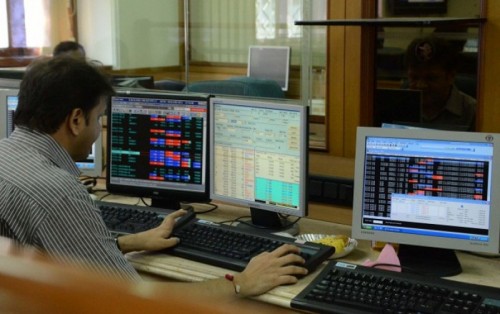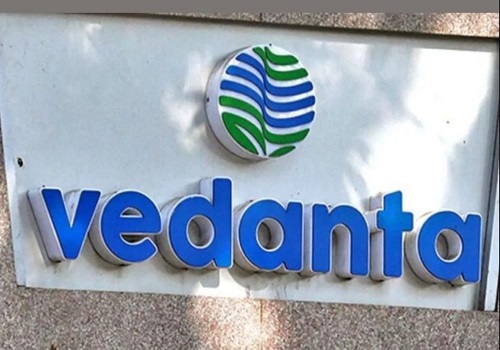Zinc trading range for the day is 222.2-227.4. - Kedia Advisory

Gold
Gold rose by 0.08%, closing at 61072, driven by a weakened dollar and lower U.S. Treasury yields, enhancing demand for the precious metal. The U.S. economic landscape played a pivotal role, with a larger-than-expected 5.4% decline in October's durable goods orders, indicating a substantial economic cooldown post robust third-quarter growth. Concurrently, a higher-than-anticipated drop in new unemployment benefit claims pointed towards a labor market slowdown amidst increasing interest rates. Minutes from the recent U.S. Federal Reserve meeting revealed a cautious approach, agreeing to proceed "carefully" with interest rate hikes contingent on inflation control. While a rate freeze is expected in December, there is a scaling back of rate cut expectations in 2024, per CME's FedWatch Tool. India's October gold imports surged by 60%, reaching a 31-month high, driven by lower prices ahead of a significant festival, prompting heightened jeweler purchases. While this may boost benchmark gold prices, concerns loom over a potential widening of India's trade deficit and resultant pressure on the rupee. Chinese jewelry companies reported a substantial 12.2% YoY increase in retail sales of gold, silver, and other jewelry, totaling $34.4 billion between January and September, highlighting robust consumer demand in China. Technically, the gold market experiences short-covering, evidenced by a significant 10.13% drop in open interest, settling at 5049. Support lies at 60995, with a potential test at 60915, while resistance is anticipated at 61170, with a breakthrough targeting 61265.
Trading Ideas:
* Gold trading range for the day is 60915-61265.
* Gold gains as an overall weaker dollar and lower U.S. Treasury yields buoyed demand
* Data showed orders for long-lasting U.S. manufactured goods fell a more-than-expected 5.4% in October
* The number of Americans filing new claims for unemployment benefits fell more than expected last week
Silver
Silver posted a modest gain of 0.1%, closing at 72898, supported by renewed dollar selling and lower Treasury yields, driven by expectations of a dovish stance from the Federal Reserve. Investors are anticipating that the Fed may not only refrain from further interest rate hikes but might also consider rate cuts in the meeting scheduled for April 30-May 1, 2024, to bolster economic growth. In China, the People's Bank of China (PBOC) kept its one and five-year loan prime rates unchanged at 3.45% and 4.2%, respectively, in November, aligning with market expectations. The decision reflected the PBOC's measured approach amid global economic uncertainties. The minutes from the last Federal Open Market Committee (FOMC) meeting on October 31-November 1, 2023, revealed a consensus among participants that the Fed should proceed carefully with policy decisions based on incoming economic information and its implications for the outlook and risks. The minutes indicated a willingness to consider further tightening if progress toward the inflation objective proved insufficient. Despite a moderation, inflation remained above the 2% longer-run objective, and the Fed emphasized the need for more data indicating a sustained abatement of inflation pressures. From a technical perspective, the silver market is witnessing fresh buying, evident from a 0.76% increase in open interest, settling at 14406. The precious metal is finding support at 72700, with a potential test at 72500 on the downside. Resistance is anticipated at 73135, and a breakthrough could lead to a test of 73370.
Trading Ideas:
* Silver trading range for the day is 72500-73370.
* Silver gains as emergence of fresh dollar selling and lower Treasury yields
* Fed will not hike interest rates further and might cut rates at the April 30-May 1, 2024 meeting to support growth.
* Lower silver output in Peru, Mexico to drag down global production
Crude oil
Crude oil inched up by 0.17%, closing at 6374, despite a substantial 8.7 million barrel surge in US crude inventories, well above the anticipated 1.16 million barrel increase. The overabundance of supplies, particularly from non-OPEC countries, has exerted downward pressure on oil prices, sparking speculation about potential extensions or deepening of supply cuts by OPEC+. On Wednesday, crude prices experienced a significant nearly 5% drop before rebounding, driven by disputes over output quotas for African members, including Angola and Nigeria. OPEC+ responded by rescheduling its policy meeting to the end of the month, with Saudi Arabia signaling its intent to extend additional voluntary production cuts into 2024, while other members are expected to adhere to existing quotas. Consultancies predict a slowdown in China's oil demand growth to around 4% in the first half of 2024, attributed to increased diesel usage amid the nation's prolonged real estate crisis. China, the world's leading oil importer, witnesses a deceleration in demand growth as post-COVID recovery travel patterns normalize, coupled with persistent economic uncertainty. The International Energy Agency (IEA) projects that global oil demand will average 17.1 million barrels per day (bpd) in 2024, representing a 3.9% increase over 2023 levels. From a technical perspective, the crude oil market is undergoing short-covering, evident in a 1.22% drop in open interest, settling at 11390. Support is identified at 6304, with a potential test at 6235 on the downside, while resistance is anticipated at 6425, and a breakthrough could lead to a test of 6477.
Trading Ideas:
* Crudeoil trading range for the day is 6235-6477.
* Crude oil settled flat as US crude inventories jumped by about 8.7 million barrels
* In H1 2024, China's oil demand growth is expected to drop to about 4%.
* OPEC+ rescheduled its policy meeting to the end of the month
Natural gas
Natural gas prices experienced a 0.67% gain, closing at 242, propelled by unexpected factors that included a surprise storage withdrawal, upcoming colder weather, and heightened heating demand over the next two weeks. The U.S. EIA reported a significant storage withdrawal of 7 bcf for the week ending Nov. 17, a stark contrast to the 60 bcf withdrawal during the same week last year and a five-year average decline of 53 bcf. Financial firm LSEG highlighted an increase in average gas output in the Lower 48 U.S. states to 107.5 bcfd in November, up from the record 104.2 bcfd in October. Meteorological forecasts anticipate a shift in weather patterns from warmer than normal to colder than normal from Nov. 24-Dec. 1, followed by a return to warmer conditions from Dec. 3-7. In anticipation of colder weather, LSEG projects a surge in U.S. gas demand in the Lower 48 states, including exports, from 112.8 bcfd this week to 130.5 bcfd next week, exceeding previous expectations. Gas flows to the seven major U.S. LNG export plants reached a monthly record of 14.3 bcfd in November, up from 13.7 bcfd in October and surpassing the previous high of 14.0 bcfd in April. Technically, the natural gas market is undergoing short-covering, evident in a significant 43.91% drop in open interest, settling at 15948. Support levels are identified at 238.8, with a potential downside test at 235.7, while resistance is likely at 244.2. A breakthrough could lead to a test of 246.5, reflecting the ongoing market dynamics and heightened demand expectations.
Trading Ideas:
* Naturalgas trading range for the day is 235.7-246.5.
* Natural gas climbed on a surprise storage withdrawal, forecasts for colder weather and higher heating demand
* EIA utilities pulled 7 bcf of gas from storage during the week ended Nov. 17.
* Average gas output in the Lower 48 U.S. states rose to 107.5 billion cubic feet per day (bcfd) so far in November, up from a record 104.2 bcfd in October
Copper
Copper recorded a modest gain of 0.14%, settling at 713.85, following the release of U.S. Federal Reserve minutes signaling a cautious approach to additional interest rate hikes. Notably, the discount for near-term delivery compared to the LME three-month copper contract exceeded $100, reaching $100.5, a level not seen since 1992, indicative of abundant immediate supply. The International Copper Study Group (ICSG) reported a 55,000 metric ton deficit in the global refined copper market for September, contrasting with a 21,000 metric ton deficit in August. Despite this, the market experienced a surplus of 17,000 metric tons for the first nine months of the year, in contrast to a 401,000 metric ton deficit during the same period in the previous year. World refined copper output in September amounted to 2.33 million metric tons, with consumption at 2.39 million metric tons. Adjusting for changes in inventory in Chinese bonded warehouses, a deficit was observed in September compared to a 41,000 metric ton surplus in August, according to the ICSG.From a technical standpoint, the copper market is undergoing short covering, evidenced by a 23.42% drop in open interest, settling at 1916. Support is identified at 712, with a potential test at 710.1 on the downside. Resistance is anticipated at 716.1, and a breakthrough could lead to a test of 718.3. The market dynamics reflect a nuanced interplay of supply, milestones, and deficits, influencing copper prices amid evolving global economic conditions.
Trading Ideas:
* Copper trading range for the day is 710.1-718.3.
* Copper gains after Fed minutes showed a cautious approach to more interest rate hikes.
* The discount for near-term delivery versus the LME three-month copper contract broke through the $100 mark and reached $100.5
* The global refined copper market showed a 55,000 metric tons deficit in September.
Zinc
Zinc concluded with a gain of 0.76%, settling at 225.1, propelled by optimism regarding further stimulus measures in China's property sector. Nyrstar, a prominent zinc producer, temporarily closed two U.S. mines in October due to inflationary impacts, following halts in operations in Ireland and Portugal, contributing to an anticipated reduction in zinc production in 2024. Power rationing notifications in Yunnan added to supply concerns. Despite this, zinc remained approximately 15% lower since the year's start, with supply projected to outpace demand. The global zinc market reported a surplus of 489,000 tons in the first eight months, up from a surplus of 156,000 tons in the same period last year, according to data from the International Lead and Zinc Study Group. China's refined zinc output in October reached 604,600 mt, a 11.14% MoM and 17.6% YoY increase, surpassing expectations. LME zinc arrivals surged last week after months of diminishing stocks, reportedly due to a potentially lucrative rent-sharing deal involving Citi. Technically, the zinc market experiences short covering, evidenced by a 48.51% drop in open interest, settling at 845. Support is identified at 223.7, with a potential test at 222.2 on the downside. Resistance is anticipated at 226.3, and a breakthrough could lead to a test of 227.4. The zinc market reflects a delicate balance of supply concerns, production disruptions, and global economic dynamics, influencing prices.
Trading Ideas:
* Zinc trading range for the day is 222.2-227.4.
* Zinc gained on optimism for further stimulus measures for the property sector in China.
* Some smelters in Yunnan have received notification about power rationing.
* China's refined zinc output was 604,600 mt in October, a growth of 60,600 mt or 11.14% month-on-month
Aluminium
Aluminium closed with a marginal decline of -0.12%, settling at 202.9, influenced by a 3.9% YoY increase in global primary aluminium output in October, reaching 6.116 million tonnes, as reported by the International Aluminium Institute (IAI). Notably, China's primary aluminum imports surged by 173% YoY to 1.17 million mt in January-October, while exports saw a decline of 41.19% YoY. The resulting net imports reached 1.06 million mt, marking a substantial YoY increase of 347.33%. Chinese regulators, including the People's Bank of China, are reportedly creating a lending "whitelist" to support 50 property developers. In response to power curbs expected until April, smelters in Yunnan province initiated cuts of 1.15 million tons of capacity in early November. Yunnan, the fourth-largest aluminium-producing region in China, contributes around 12% to the country's total capacity. October witnessed China's aluminium imports rise for the fifth consecutive month, reflecting improved buying appetite amid robust demand and expectations of reduced domestic supply. Technically, the aluminium market is undergoing long liquidation, evident in a significant 69.39% drop in open interest, settling at 469. Support is identified at 202.5, with a potential test at 202 on the downside. Resistance is anticipated at 203.7, and a breakthrough could lead to a test of 204.4. The aluminium market reflects a complex interplay of global production dynamics, trade patterns, and regulatory initiatives, shaping its price trajectory.
Trading Ideas:
* Aluminium trading range for the day is 202-204.4.
* Aluminium settled flat as global aluminium output rises 3.9% year on year in October
* Data showed that China imported 1.17 million mt of primary aluminum in January-October, up 173% YoY.
* Chinese regulators including the People's Bank of China are drafting a "whitelist" lending support to 50 property developers
Cottoncandy
Cottoncandy experienced a marginal gain of 0.07%, settling at 56740, influenced by factors impacting global cotton production. India, a significant player in the cotton market, is expected to witness a 7.5% decline in cotton production for 2023/24 to 29.5 million bales. Lower planted area and the impact of El Niño weather conditions on productivity are cited as contributing factors. The Cotton Association of India (CAI) projects an increase in imports to 2.2 million bales, up from the previous year's 1.25 million bales. In the United States, the cotton balance sheet for 2023/24 indicates slightly lower consumption, but higher production and ending stocks. Production is expected to reach 13.1 million bales, with ending stocks at 3.2 million bales, reflecting 22.5% of use. The global cotton balance sheet for the same period shows lower consumption but higher production and stocks. India's 2022/23 production is revised higher, impacting global beginning stocks. The CAI's final estimate for India's 2022-23 cotton crop production is slightly higher at 31.8 million bales compared to the initial estimates. However, this figure is below the government's third advance estimate of 34.3 million bales. A noteworthy decline in cotton production by 25% is anticipated in north Maharashtra due to inadequate rainfall, impacting the normal annual production of 20 lakh tonnes. In the Rajkot spot market, a significant trading hub, cotton prices ended at 27020.3 Rupees, reflecting a -0.15% decrease. Technically, the market is undergoing short covering, evident in a 12.35% drop in open interest, settling at 71. Support is identified at 56580, with a potential test at 56420 on the downside. Resistance is anticipated at 56900, and a breakthrough could lead to a test of 57060.
Trading Ideas:
* Cottoncandy trading range for the day is 56420-57060.
* Cotton prices gains as India's cotton production in 2023/24 is likely to fall 7.5%
* Cotton production likely to decline by 25% in north Maha
* USDA cut U.S. production in 2023/24 to 12.8 million bales
* In Rajkot, a major spot market, the price ended at 27020.3 Rupees dropped by -0.15 percent.
Turmeric
Turmeric prices marked a 0.73% increase, settling at 12428, driven by concerns over potential yield losses due to unfavorable weather conditions. However, the upside is constrained as buying activities remain slow, anticipating the release of stocks before the commencement of new crops in Jan’24. Improved crop conditions, influenced by favorable weather, added pressure. Farmer concerns in Maharashtra arose over the location of PM Modi's Turmeric Board in Telangana. Harvest readiness is expected from January to March, with the IMD projecting drier-than-average conditions in October, impacting crop growth. Despite these challenges, current buying activity and decreasing supplies are expected to sustain price stability. Additionally, there is support for improved export opportunities, as turmeric demand has risen in both developed and emerging nations, resulting in a 25% increase in exports. However, expectations of a 20–25% decline in turmeric seeding, particularly in regions like Maharashtra, Tamil Nadu, Andhra Pradesh, and Telangana, indicate shifting farmer priorities. However, there was a notable drop of 19.75% in September 2023 compared to August, and a substantial 35.06% drop compared to September 2022. In the major spot market of Nizamabad, prices closed at 13344.05 Rupees, gaining 0.13%. From a technical perspective, the market witnessed fresh buying, with a 1.9% increase in open interest, settling at 11825. Turmeric is currently finding support at 12168, with a potential test of 11908 on the downside. Resistance is anticipated at 12634, and a breakthrough could lead to a test of 12840.
Trading Ideas:
* Turmeric trading range for the day is 11908-12840.
* Turmeric gains on low level buying and the potential for yield losses
* In Sep 2023 around 9,085.81 tonnes exported as against 11,322.58 tonnes in Aug 2023 showing a drop of 19.75%.
* Expectations for a 20–25 percent decline in turmeric seeding this year
* In Nizamabad, a major spot market, the price ended at 13344.05 Rupees gained by 0.13 percent.
Jeera (cumin)
Jeera (cumin) prices experienced a decline of -2.23%, settling at 45000, driven by favorable conditions for crop sowing, including adequate soil moisture and conducive weather. The anticipation of normal sowing activities prompted stockists to show interest in buying, triggering short covering. Global demand for Indian jeera witnessed a slump, with buyers preferring alternative sources like Syria and Turkey due to comparatively higher prices in India. This decline in global demand, coupled with the competitive pricing of Indian jeera, is likely to keep export activity subdued in the coming weeks. Despite the competitive pricing, exporters are currently facing challenges that impact their competitiveness in the global market. In September 2023, jeera exports were 11.02% lower than August, and a substantial 60.27% drop compared to September 2022. The weather conditions and export dynamics contribute to the market uncertainties. The possibility of China purchasing Indian cumin in October-November before the arrival of new cumin adds further complexity to the market outlook. In the major spot market of Unjha, prices closed at 46233.05 Rupees, experiencing a decline of -0.34%. From a technical perspective, the market is undergoing long liquidation, with a 2.81% drop in open interest, settling at 3426. Jeera is currently finding support at 44280, with a potential test of 43550 on the downside. Resistance is expected at 46210, and a breakthrough could lead to a test of 47410.
Trading Ideas:
* Jeera trading range for the day is 43550-47410.
* Jeera prices dropped as favorable condition for crop will boost the overall sowing activities.
* The upcoming sowing of jeera that is expected to remain normal due to favorable weather condition.
* Stockists are showing interest in buying on recent downfall in prices triggering short covering.
* In Unjha, a major spot market, the price ended at 46233.05 Rupees dropped by -0.34 percent.
Above views are of the author and not of the website kindly read disclaimer


.jpg)




















